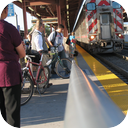(short preview of full seamless looping track)
Early Train Departure
This product is not available in the selected currency.
In Stock
Backordered
Out of Stock
Description
The platform, sunny and clean, is suddenly filled with gloomy people who stand impotent, having just missed the train as it pulls away earlier than expected. You too linger along the tracks, trying to force this reality to go away, hopefully making it a strange dream, waking up with a train waiting for you to board, but naturally when you open your eyes all you see is nothing. You give up feeling sorry for yourself and lumber back to the station, perhaps they have something warm to eat. One notable and growing long-distance train category is high-speed rail. Generally, high speed rail runs at speeds above 200 km/h (124 mph) and often operates on dedicated track that is surveyed and prepared to accommodate high speeds. Japan's Shinkansen ("bullet-train") commenced operation in 1964, and was the first successful example of a high speed passenger rail system. The fastest wheeled train running on rails is France's TGV (Train à Grande Vitesse, literally "high speed train"), which achieved a speed of 574.8 km/h (357.2 mph), twice the takeoff speed of a Boeing 727 jetliner, under test conditions in 2007. The highest speed currently attained in scheduled revenue operation is 350 km/h (217 mph) on the Beijing–Tianjin Intercity Rail and Wuhan–Guangzhou High-Speed Railway systems in China. The TGV runs at a maximum revenue speed of 300–320 km/h (186–199 mph), as does Germany's Inter-City Express. In most cases, high-speed rail travel is time and cost-competitive with air travel when distances do not exceed 500 to 600 km (311 to 373 mi), as airport check-in and boarding procedures may add as many as two hours to the actual transit time.
Opps
Sorry, it looks like some products are not available in selected quantity.



